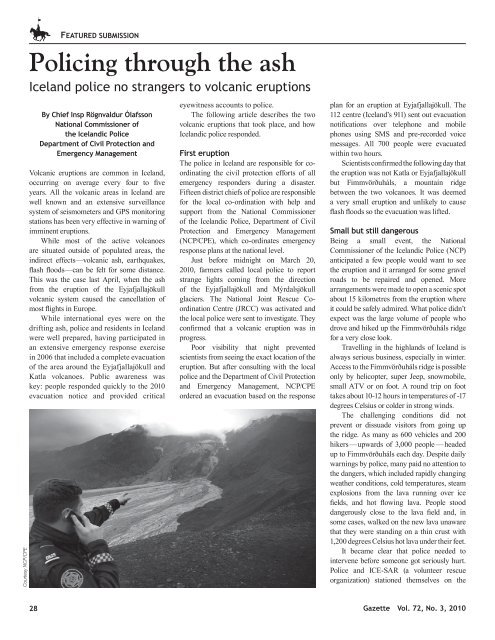RCMP Gazette Human Rights and Policing - Alberta Hate Crimes ...
RCMP Gazette Human Rights and Policing - Alberta Hate Crimes ...
RCMP Gazette Human Rights and Policing - Alberta Hate Crimes ...
You also want an ePaper? Increase the reach of your titles
YUMPU automatically turns print PDFs into web optimized ePapers that Google loves.
FEATuRED SubMiSSiON<strong>Policing</strong> through the ashIcel<strong>and</strong> police no strangers to volcanic eruptionsCourtesy NCP/CPEby Chief insp Rögnvaldur ÓlafssonNational Commissioner ofthe icel<strong>and</strong>ic PoliceDepartment of Civil Protection <strong>and</strong>Emergency ManagementVolcanic eruptions are common in Icel<strong>and</strong>,occurring on average every four to fiveyears. All the volcanic areas in Icel<strong>and</strong> arewell known <strong>and</strong> an extensive surveillancesystem of seismometers <strong>and</strong> GPS monitoringstations has been very effective in warning ofimminent eruptions.While most of the active volcanoesare situated outside of populated areas, theindirect effects—volcanic ash, earthquakes,flash floods—can be felt for some distance.This was the case last April, when the ashfrom the eruption of the Eyjafjallajökullvolcanic system caused the cancellation ofmost flights in Europe.While international eyes were on thedrifting ash, police <strong>and</strong> residents in Icel<strong>and</strong>were well prepared, having participated inan extensive emergency response exercisein 2006 that included a complete evacuationof the area around the Eyjafjallajökull <strong>and</strong>Katla volcanoes. Public awareness waskey: people responded quickly to the 2010evacuation notice <strong>and</strong> provided criticaleyewitness accounts to police.The following article describes the twovolcanic eruptions that took place, <strong>and</strong> howIcel<strong>and</strong>ic police responded.First eruptionThe police in Icel<strong>and</strong> are responsible for coordinatingthe civil protection efforts of allemergency responders during a disaster.Fifteen district chiefs of police are responsiblefor the local co-ordination with help <strong>and</strong>support from the National Commissionerof the Icel<strong>and</strong>ic Police, Department of CivilProtection <strong>and</strong> Emergency Management(NCP/CPE), which co-ordinates emergencyresponse plans at the national level.Just before midnight on March 20,2010, farmers called local police to reportstrange lights coming from the directionof the Eyjafjallajökull <strong>and</strong> Mýrdalsjökullglaciers. The National Joint Rescue CoordinationCentre (JRCC) was activated <strong>and</strong>the local police were sent to investigate. Theyconfirmed that a volcanic eruption was inprogress.Poor visibility that night preventedscientists from seeing the exact location of theeruption. But after consulting with the localpolice <strong>and</strong> the Department of Civil Protection<strong>and</strong> Emergency Management, NCP/CPEordered an evacuation based on the responseplan for an eruption at Eyjafjallajökull. The112 centre (Icel<strong>and</strong>’s 911) sent out evacuationnotifications over telephone <strong>and</strong> mobilephones using SMS <strong>and</strong> pre-recorded voicemessages. All 700 people were evacuatedwithin two hours.Scientists confirmed the following day thatthe eruption was not Katla or Eyjafjallajökullbut Fimmvörðuháls, a mountain ridgebetween the two volcanoes. It was deemeda very small eruption <strong>and</strong> unlikely to causeflash floods so the evacuation was lifted.Small but still dangerousBeing a small event, the NationalCommissioner of the Icel<strong>and</strong>ic Police (NCP)anticipated a few people would want to seethe eruption <strong>and</strong> it arranged for some gravelroads to be repaired <strong>and</strong> opened. Morearrangements were made to open a scenic spotabout 15 kilometres from the eruption whereit could be safely admired. What police didn’texpect was the large volume of people whodrove <strong>and</strong> hiked up the Fimmvörðuháls ridgefor a very close look.Travelling in the highl<strong>and</strong>s of Icel<strong>and</strong> isalways serious business, especially in winter.Access to the Fimmvörðuháls ridge is possibleonly by helicopter, super Jeep, snowmobile,small ATV or on foot. A round trip on foottakes about 10-12 hours in temperatures of -17degrees Celsius or colder in strong winds.The challenging conditions did notprevent or dissuade visitors from going upthe ridge. As many as 600 vehicles <strong>and</strong> 200hikers—upwards of 3,000 people — headedup to Fimmvörðuháls each day. Despite dailywarnings by police, many paid no attention tothe dangers, which included rapidly changingweather conditions, cold temperatures, steamexplosions from the lava running over icefields, <strong>and</strong> hot flowing lava. People stooddangerously close to the lava field <strong>and</strong>, insome cases, walked on the new lava unawarethat they were st<strong>and</strong>ing on a thin crust with1,200 degrees Celsius hot lava under their feet.It became clear that police needed tointervene before someone got seriously hurt.Police <strong>and</strong> ICE-SAR (a volunteer rescueorganization) stationed themselves on the28<strong>Gazette</strong> Vol. 72, No. 3, 2010







